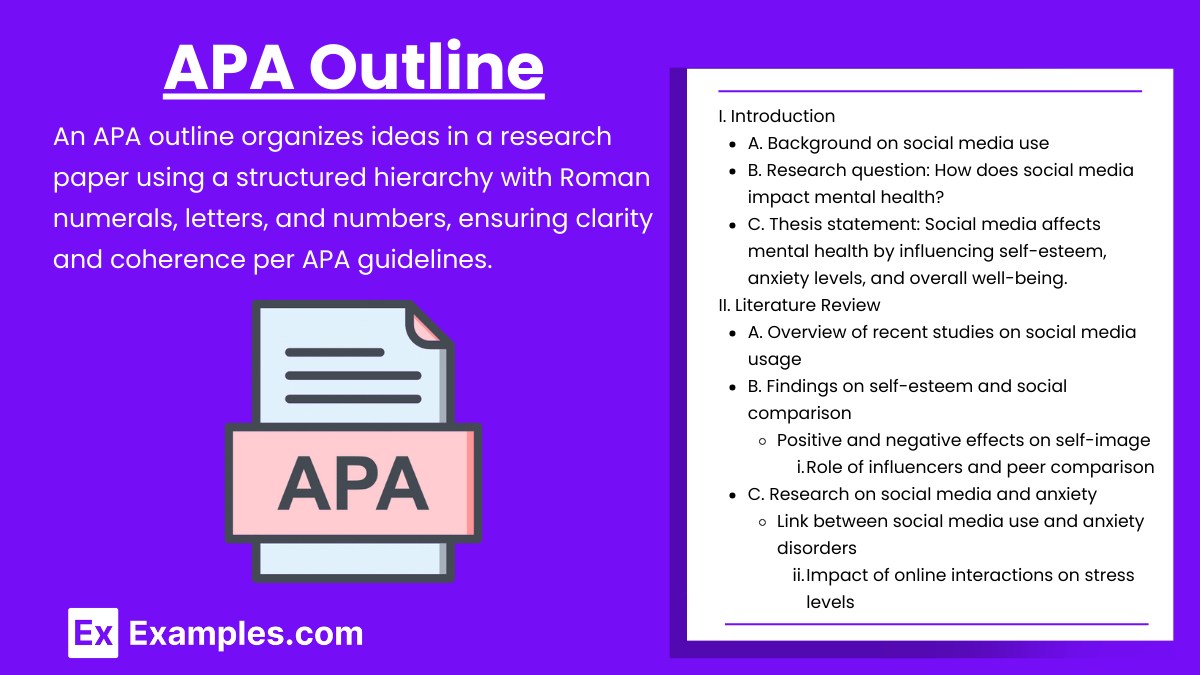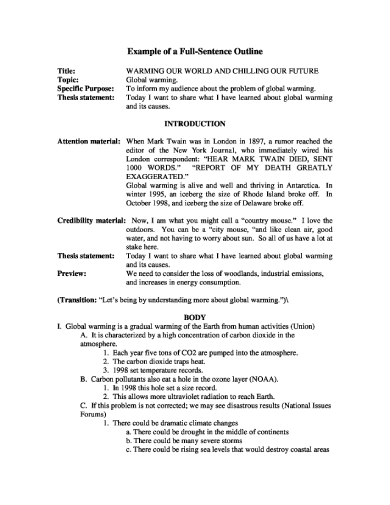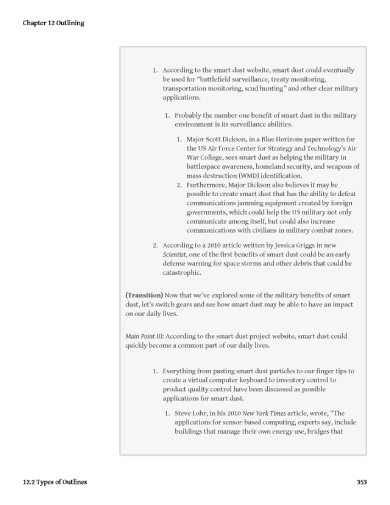10+ APA Outline Examples to Download
If you’re a beginner in writing a research paper or an essay and your instructor asked you to use the APA format, you may not have the faintest idea what APA means, let alone use the format. If your instructor gives you the APA guidelines then good for you. If they haven’t, don’t panic. You’re going through the perfect article that will help you get acquainted and familiarize the APA format outline. You may also see essay outline.
Most college students or teachers who are majoring in social sciences, such as Psychology, Sociology, History, Linguistics, use the American Psychological Association or APA guidelines for writing research papers and assignments in this field of study. Other fields of study also use the APA format but not limited to Business, Economics, Nursing, and Criminology. The APA covers the initial title page to bibliography citation page. APA basically provides the basic layout style and outline to correctly write your paper in the APA format. Of course, other formats are also used by researchers, students, and teachers such as MLA, Harvard, etc. You may also see free outline.
What is an APA Outline?
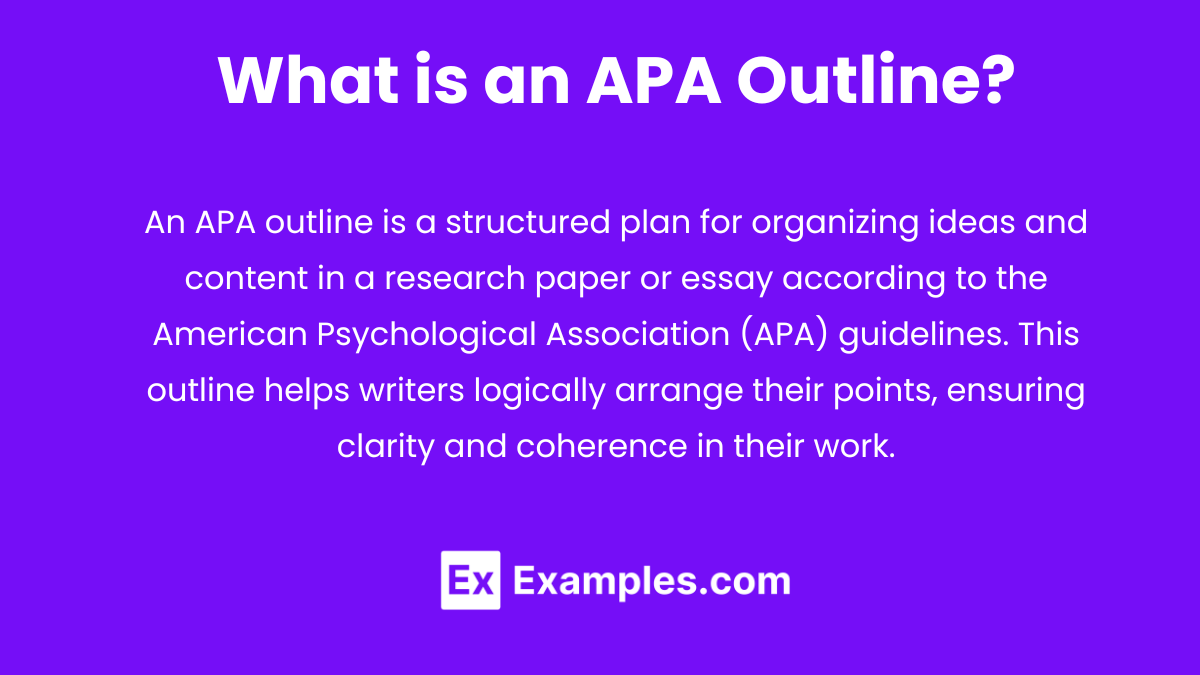
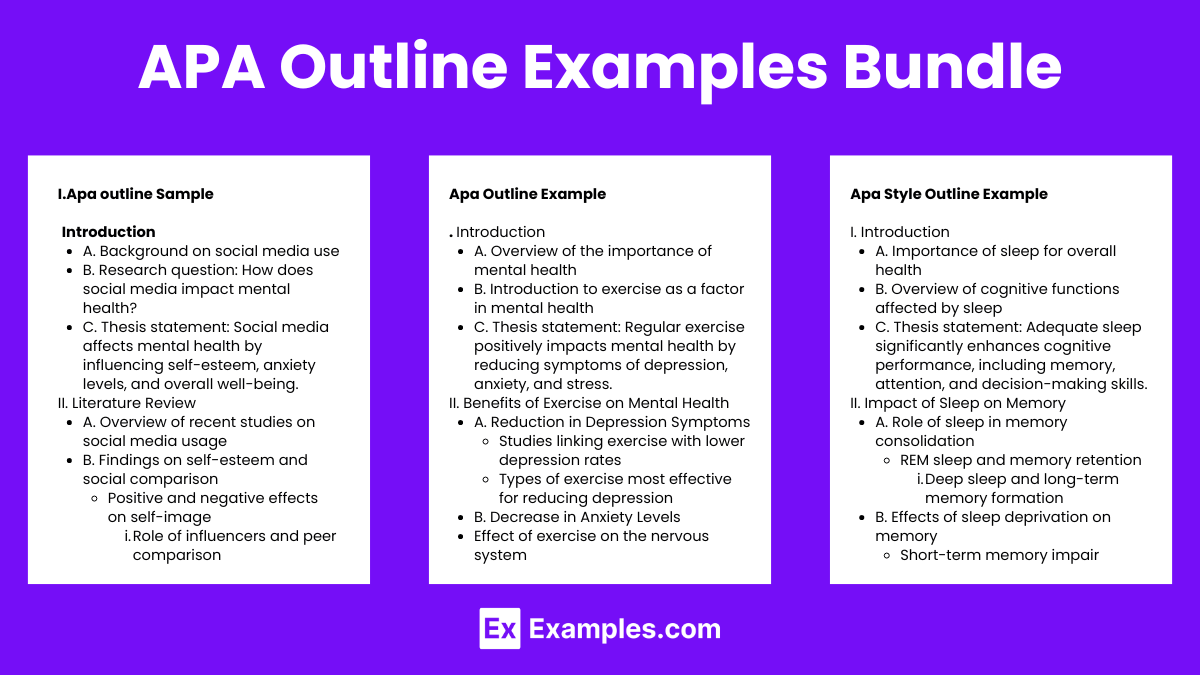
Download APA Outline Examples Bundle
Apa Outline Format
An APA outline format is a structured way to organize ideas and main points in a research paper according to the American Psychological Association (APA) style. This format helps writers create a clear hierarchy, making it easier to present ideas logically. Here’s how to structure an APA outline:
General Structure
Each level is indented to indicate its place in the hierarchy.
Example of an APA Outline
Here is a sample structure:
I. Introduction
- A. Background information
- B. Purpose of the paper
- C. Thesis statement
II. Literature Review
- A. Previous research on the topic
- B. Gaps in the current research
- C. Theoretical framework
III. Methodology
- A. Research design
- B. Data collection methods
- C. Analysis approach
IV. Results
- A. Key findings
- B. Data presentation
- C. Summary of results
V. Discussion
- A. Interpretation of findings
- B. Implications for future research
- C. Limitations of the study
VI. Conclusion
- A. Recap of major points
- B. Final thoughts
- C. Recommendations
Additional Formatting Tips
- Double-space the outline, following APA guidelines.
- Align text consistently, with each level indented further than the one above.
- Use parallel structure by keeping similar headings grammatically consistent (e.g., all verb phrases or all noun phrases).
The APA outline format is an effective way to organize and structure ideas, ensuring a logical flow that supports the development of a well-organized paper.
The APA outline format typically uses the following order for headings:
- Roman numerals (I, II, III) for main topics
- Capital letters (A, B, C) for primary subtopics
- Arabic numerals (1, 2, 3) for secondary subtopics
- Lowercase letters (a, b, c) for supporting details
APA Outline Style
The APA outline style is used to organize and structure the content of a research paper according to the American Psychological Association (APA) guidelines. This style ensures clarity, coherence, and a logical flow of information. Here’s a guide to using APA outline style effectively:
Structure of an APA Outline
The outline format uses a specific hierarchical system with the following order:
- Roman Numerals (I, II, III): Main headings or major sections of the paper.
- Capital Letters (A, B, C): First-level subheadings under each main heading.
- Arabic Numerals (1, 2, 3): Second-level subheadings that further break down the information.
- Lowercase Letters (a, b, c): Third-level subheadings or supporting details.
Each level should be indented to show the hierarchy and relation between topics and subtopics.
Apa outline Sample
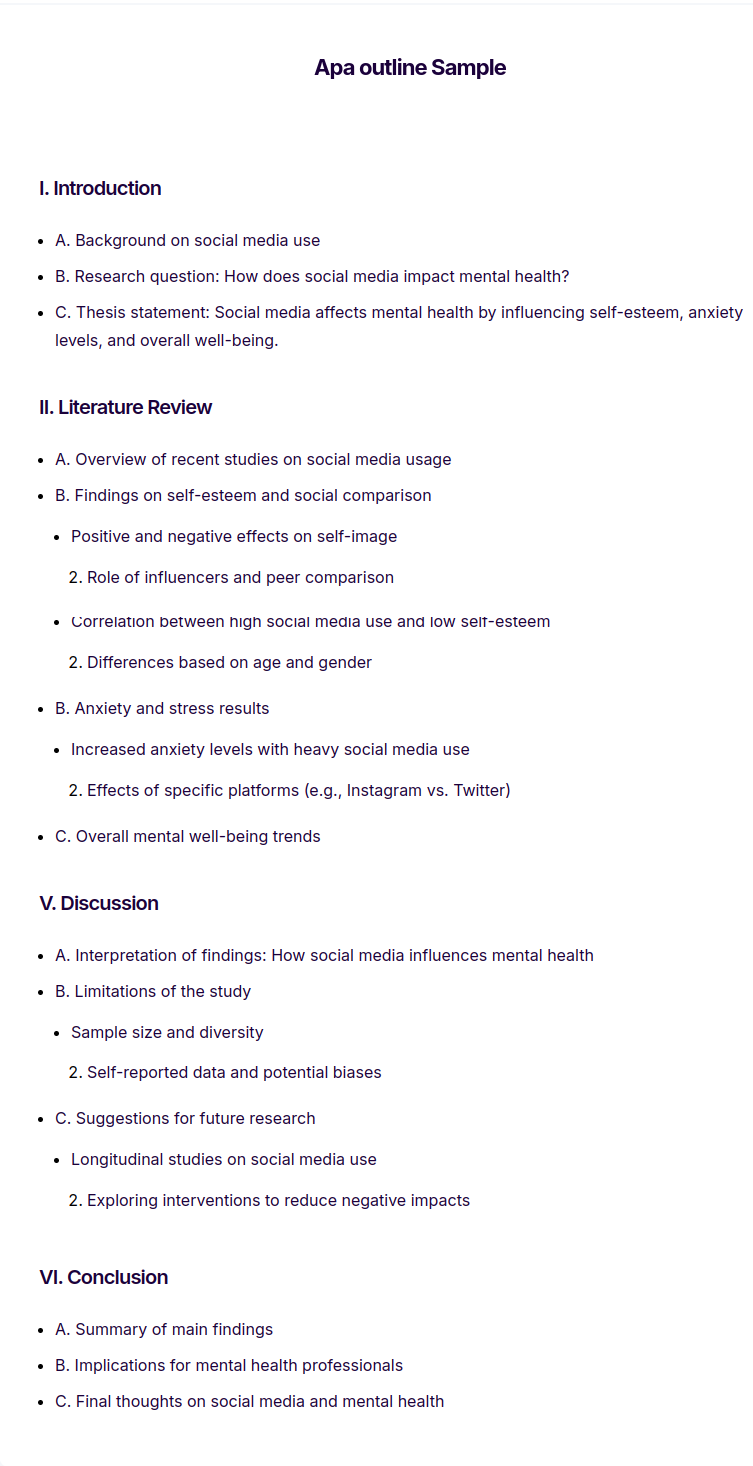
Apa Outline Example
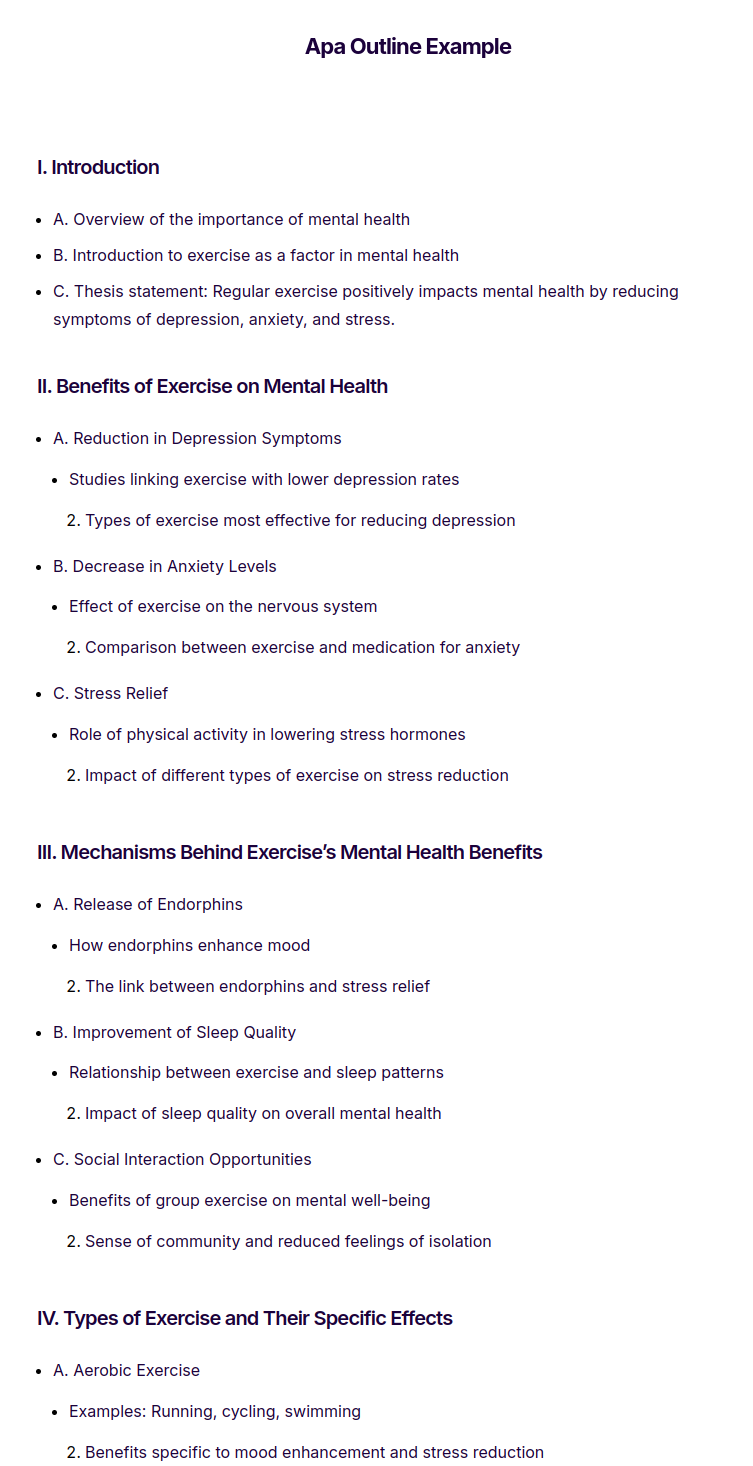
Apa Style Outline Example
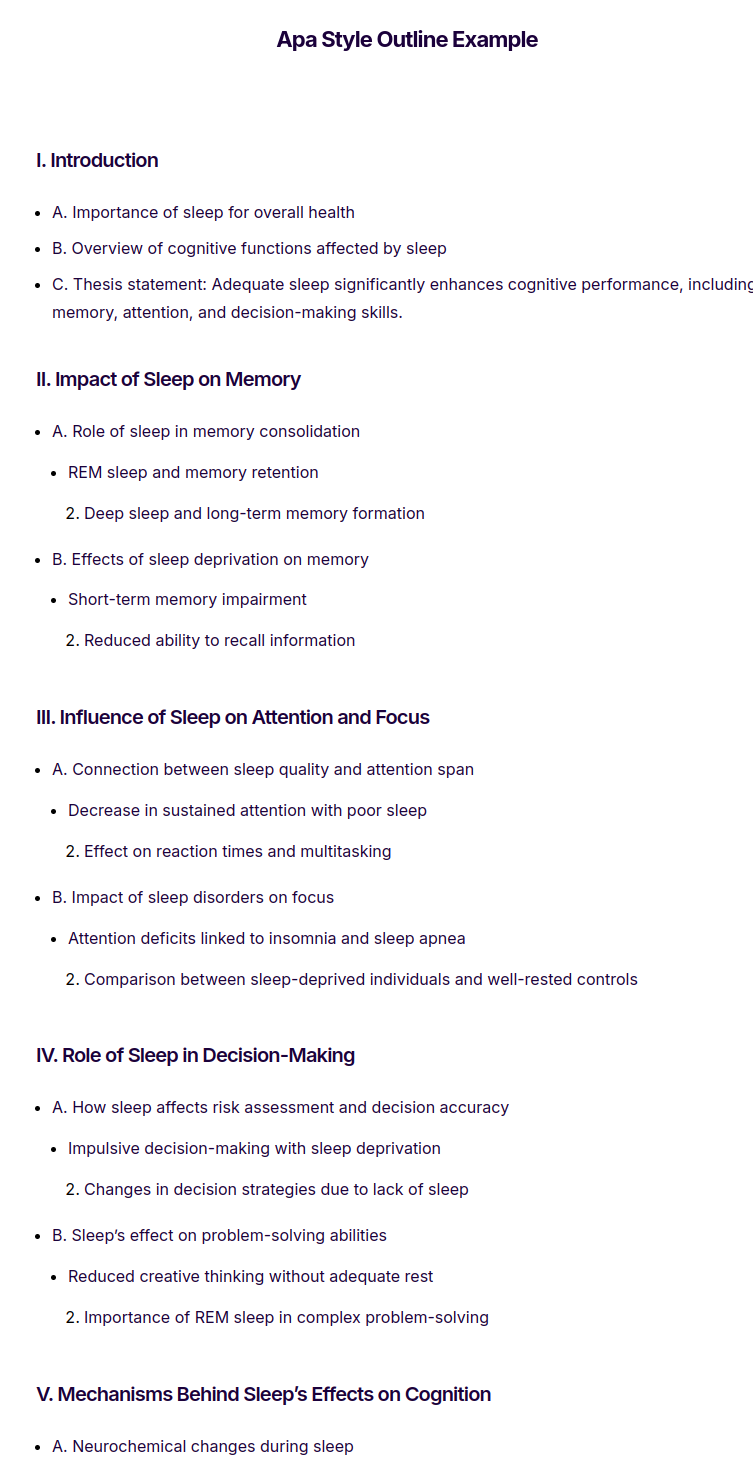
More Apa Style Outline Samples
Radio Outline Format Example
 emmabender.com
emmabender.comFull-Sentence Outlines
Basic Full-Sentence Outline
Though there are only a few differences between an alphanumeric outline and a full-sentence outline, you might still need a sample to illustrate these variations. See this simple full-sentence outline sample to learn more.
Full-Sentence Outline Example
What is an APA Outline Format?
APA stands for American Psychological Association, and an APA outline format is a standardized format for outlining papers and other documents. An APA outline format is typically used for research papers, dissertations, and theses. It is a way to organize your ideas and thoughts in a clear and concise manner before writing your paper.
How to write an APA Outline Format
Using an APA format as your outline might be confusing at first but once you have familiarize yourself with the format, then it is easier for you to organize your topics and sub-topics you want to discuss in your essay or research paper. You may also see book outline.
Having a good outline has more chances of you presenting a well-written research paper or essay. Making an APA outline is the first thing to do in creating a structure on what will be written in the paper and how it is written. There is a grammatical format that you have to follow while writing your paper to make it sound credible. Having a sloppy grammar makes your paper less impressive. Here are some tips:
1. Observe the use of parallelism.
Parallelism means the use of consecutive verbal constructions in a sentence that corresponds to the grammatical structure. In this format, this refers to the structure between the headings and sub-headings. Once you’ve established your structure, it must be consistent with all your headings and subheadings. If you start your headings with a verb, then your subheadings should start with a verb. If you use a noun, then all your headings and sub-headings must use nouns. You may also see write a speech outline.
2. The use of coordination is vital between your headings.
All your headings must be equal in significance or importance of each other. The rule applies to sub-headings as well, but their information may be less significant than the headings. You may also see a speech outline.
3. Make use of subordination.
Subordination is the relationship between the headings and the sub-headings. The headings usually have general information while the information contained in the sub-headings are more specific, and so on to more sub-headings. The subordination is created using Arabic numerals. You may also see the program outline.
4. To organize your outline you should use division.
Each heading must have at least two or three divisions. However, if you have too many divisions, you need to use another heading or sub-heading. You may also see a biography outline.
5. Your headings should always use Roman Numerals (I, II, III, etc.) when you list them.
For example, if you are writing research for The Foundation of Mugs, your heading must look like this:
I. The Foundation of Mugs
Don’t forget to always use Roman Numerals while writing your main headings. Your heading is the first and basic step in formatting your APA outline. You may also see the chapter outline.
6. Next is the subheading.
The subheading follows the main heading. When listing them use a capital letter of the English alphabet. In the example above, your heading was “The Foundation of Mugs”. Suppose your subheading is “History of Mugs” then it should be listed using the English alphabet. Start with the capital letter A. You may also see the presentation outline.
7. Add more than one subheading to your main heading
If you like to add more than one subheading to your main heading, just by adding the next English alphabet in capital letters in the next subheading. Example: If you like to add a second subheading to your main heading, “Foundation of Mugs”, you may write this:
B. Designs and Functions of Mugs to the Society
Your heading and subheading will look like this:
I. Foundation of Mugs
A. History of Mugs
B. Designs and Functions of Mugs to the Society
Use Arab numerals (1,2,3 and so on). If you want to add another subheading “Decoration” under heading B, you may write it like this:
1. Decoration
Your outline would now look something like this:
I. Foundation of Mugs
A.History of Mugs
B. Designs and Functions of Mugs to the Society
1. Decoration
Finally, if there are still more subheadings you want to add under your last subheadings, use lowercase letters. If there are still subheadings you want to add under the last subheading, use Arab numerals in parenthesis. You may also see the course outline.
How do I create an APA outline format?
To create an APA outline format, start by identifying the main points you want to make in your paper. Then, organize those points into sections and subsections using headings and subheadings. Finally, add supporting details and evidence to each section to create a complete and well-organized outline.
[/ns_row]
In conclusion, an APA outline format is a helpful tool for organizing your ideas and thoughts before you start writing your paper. Whether you are working on a thesis outline, script outline, research paper outline, or book outline, using an APA outline format can help you to create a clear and organized document that is easy to read and follow. By following the guidelines and structure provided by APA outline format, you can ensure that your paper is well-organized, logical, and easy to understand.
FAQ’s
How do I format an APA outline?
An APA outline uses a specific order for headings: Roman numerals (I, II, III) for main topics, capital letters (A, B, C) for primary subtopics, Arabic numerals (1, 2, 3) for secondary subtopics, and lowercase letters (a, b, c) for further details. Each level should be indented to show the structure clearly.
Is an APA outline required for all APA-style papers?
No, an APA outline is not required for all APA-style papers. However, many instructors or institutions may recommend or require an outline to help organize ideas. Outlines are especially useful for lengthy or complex papers, as they help ensure a logical flow of information.
Should I use full sentences or bullet points in an APA outline?
APA does not specify whether to use full sentences or bullet points in outlines. You can use either, depending on your preference or instructor’s guidelines. Full sentences provide more detail, while bullet points can make the outline concise and easy to read.
Do I need to include the outline in the final version of my APA paper?
Generally, the outline is not included in the final version of an APA paper unless explicitly required by an instructor. It serves as a planning tool to organize your content and ensure that all relevant points are covered systematically before you start writing the full paper.
Can I modify the structure of an APA outline to suit my paper’s needs?
Yes, you can modify the structure of an APA outline to fit the specific needs of your paper. While the basic hierarchy (Roman numerals, capital letters, Arabic numerals, lowercase letters) should be maintained, you can add or remove levels, as needed. Adjust the outline to ensure it effectively organizes your content and reflects the flow of your paper.


